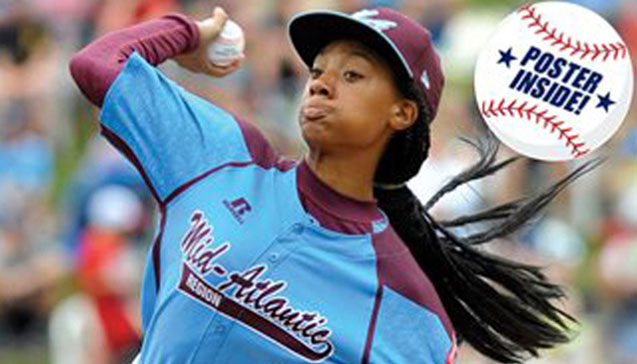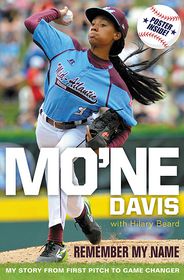Catch Mo’ne Davis’s New Memoir Remember My Name

Even if you don’t know sports, you know Mo’ne Davis. And you likely know her as the first girl to ever pitch a shutout in the Little League World Series.
She’s also the first girl to get a win in the LLWS, the first African-American girl to even play in the series, and the first Little League player to ever be on the cover of Sports Illustrated.
Mo'ne Davis: Remember My Name: My Story from First Pitch to Game Changer
Mo'ne Davis: Remember My Name: My Story from First Pitch to Game Changer
By Mo'ne Davis
Hardcover $16.99
But to those who really know her—or those who get to know her by reading her new memoir, Mo’ne Davis: Remember My Name, out March 17—she’s just Mo: humble, hardworking, down-to-earth, an honor-roll student, a great teammate, and in many ways, a totally normal teenage girl who likes goofing around with her friends and freaks out over the group Fifth Harmony.
Co-written with Hilary Beard, Mo’ne’s memoir follows her journey to the LLWS—including the first time she met her coach, Steve Bandura; her experiences playing with, against, and oftentimes better than the boys; her team’s barnstorming tour across the country; meetings with celebrities and her sports idols; and, after her LLWS shot to stardom, a trip to the White House.
One of the most interesting things about the book—and about Mo’ne herself—is her Zen nature about nearly everything in her life, including the sacrifices she makes to get a good education (she commutes hours each day by bus and is often up into the wee hours of the morning doing homework) and to not only become better in all three sports she plays but to also help her team be better.
She’s even surprisingly nonchalant about living in what many would likely describe as a rough area. In fact, she only briefly hints at it, writing, “My life hasn’t always been the most convenient or comfortable, but I’ve tried to live up to the challenge.”
She also mentions that, in her South Philadelphia neighborhood, “sometimes there is a lot going on, and not all of it is good.” In part due to her mother’s protective nature and Mo’ne’s involvement with her new school, she didn’t even know someone was murdered in front of a store on her block when it first happened.
But Mo’ne is far from naive. She’s quick to recognize that hard work, determination, a bit of luck, and a lot of support from her family, teammates, and friends are what helped her get to where she is today. She also comes across as incredibly respectful and deeply appreciative of those who came before her—both in and out of the sports arena—like Jackie Robinson, singer Marian Anderson, and famed pitcher Mamie “Peanut” Johnson.
Mo’ne even made a sculpture after meeting Mamie called Peanut and Me, comprised of “two white circles of clay, like baseballs, with a big one on the bottom and a little one on top. She was the big circle, and the little one standing on her shoulders was me.”
Some people may suggest that at 13 Mo’ne is too young to have experienced enough to write a memoir, but her poise, modesty, and sportsmanlike conduct are already far beyond her years. With a bright future ahead of her—she dreams of playing basketball at the University of Connecticut and then going on to the WNBA—this young lady surely will have more inspiring stories to tell and lessons to teach a younger generation.
But as for her first memoir, the main takeaway for readers isn’t that they should strive to be Mo’ne Davis; it’s that they should strive to be the best version of themselves—a great lesson to learn at any age.
Have you read Mo’ne Davis: Remember My Name?
But to those who really know her—or those who get to know her by reading her new memoir, Mo’ne Davis: Remember My Name, out March 17—she’s just Mo: humble, hardworking, down-to-earth, an honor-roll student, a great teammate, and in many ways, a totally normal teenage girl who likes goofing around with her friends and freaks out over the group Fifth Harmony.
Co-written with Hilary Beard, Mo’ne’s memoir follows her journey to the LLWS—including the first time she met her coach, Steve Bandura; her experiences playing with, against, and oftentimes better than the boys; her team’s barnstorming tour across the country; meetings with celebrities and her sports idols; and, after her LLWS shot to stardom, a trip to the White House.
One of the most interesting things about the book—and about Mo’ne herself—is her Zen nature about nearly everything in her life, including the sacrifices she makes to get a good education (she commutes hours each day by bus and is often up into the wee hours of the morning doing homework) and to not only become better in all three sports she plays but to also help her team be better.
She’s even surprisingly nonchalant about living in what many would likely describe as a rough area. In fact, she only briefly hints at it, writing, “My life hasn’t always been the most convenient or comfortable, but I’ve tried to live up to the challenge.”
She also mentions that, in her South Philadelphia neighborhood, “sometimes there is a lot going on, and not all of it is good.” In part due to her mother’s protective nature and Mo’ne’s involvement with her new school, she didn’t even know someone was murdered in front of a store on her block when it first happened.
But Mo’ne is far from naive. She’s quick to recognize that hard work, determination, a bit of luck, and a lot of support from her family, teammates, and friends are what helped her get to where she is today. She also comes across as incredibly respectful and deeply appreciative of those who came before her—both in and out of the sports arena—like Jackie Robinson, singer Marian Anderson, and famed pitcher Mamie “Peanut” Johnson.
Mo’ne even made a sculpture after meeting Mamie called Peanut and Me, comprised of “two white circles of clay, like baseballs, with a big one on the bottom and a little one on top. She was the big circle, and the little one standing on her shoulders was me.”
Some people may suggest that at 13 Mo’ne is too young to have experienced enough to write a memoir, but her poise, modesty, and sportsmanlike conduct are already far beyond her years. With a bright future ahead of her—she dreams of playing basketball at the University of Connecticut and then going on to the WNBA—this young lady surely will have more inspiring stories to tell and lessons to teach a younger generation.
But as for her first memoir, the main takeaway for readers isn’t that they should strive to be Mo’ne Davis; it’s that they should strive to be the best version of themselves—a great lesson to learn at any age.
Have you read Mo’ne Davis: Remember My Name?
